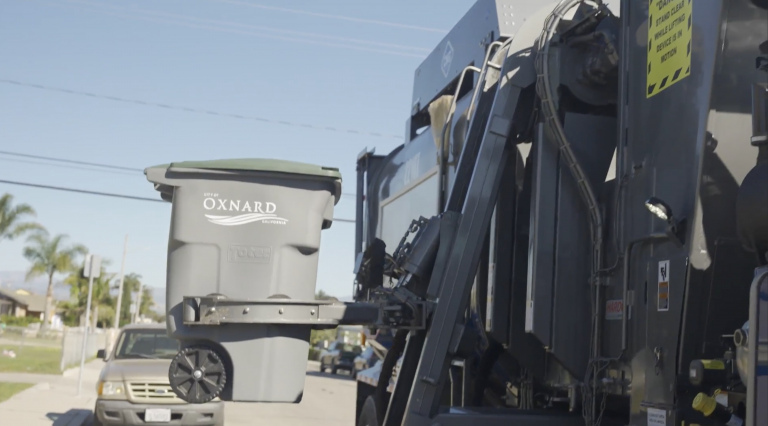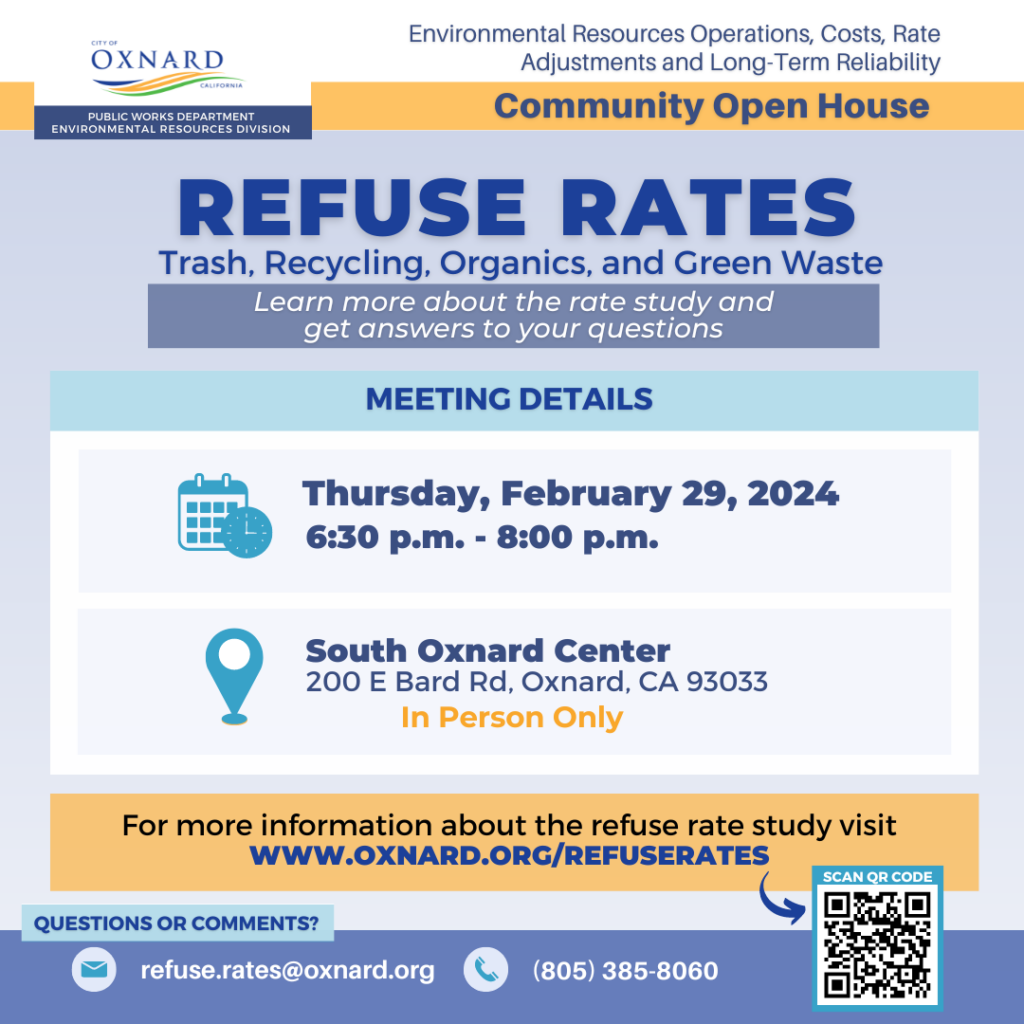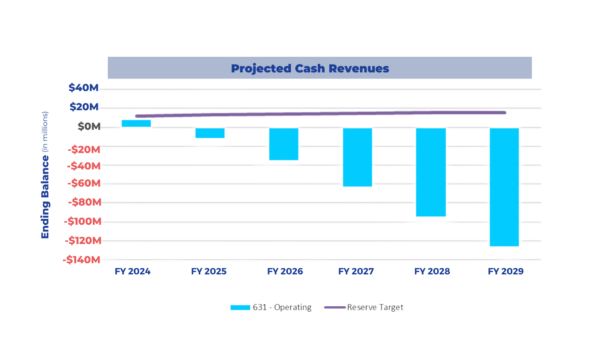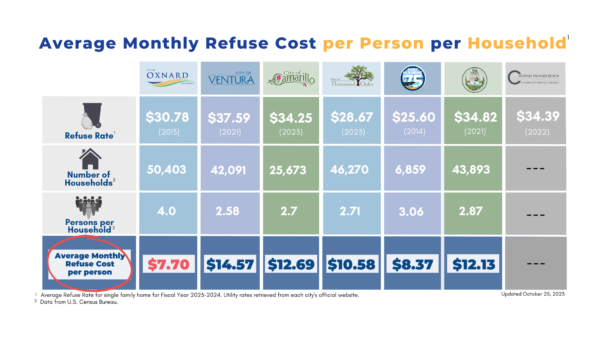Oxnard’s Environmental Resources Division is responsible for collecting refuse (including trash, recycling, organics, and green waste) and recycling solid and organic waste generated by residential, commercial and industrial users in Oxnard.

The Environmental Resources Division protects public health and the environment by safely and efficiently disposing of trash and recyclables, and ensures compliance with local, state and federal laws relating to trash disposal and recycling.
It is a common industry-standard to perform comprehensive utility cost of service studies every three to five years. The City’s Environmental Resources Division has not increased its rates since 2013. The cost of trash collection is not fixed and can rise over time due to various factors. These factors include higher fuel costs, increased labor costs, inflation, and the need to comply with State-mandated trash collection and recycling laws.
To ensure best business practices, the City hired Raftelis Inc., a firm with extensive experience developing long-range financial plans for utility services, to conduct a comprehensive solid waste cost of service study that considers key factors that affect future operations and reliability.
Raftelis’ financial consultants and City staff have been working on a series of steps involving data evaluation and technical analyses to calculate customer rates while considering customer impacts of any rate modifications.
The goal of the rates study is to ensure that the rates customers pay for refuse (solid waste) services are:
- Fair, equitable, and aligned with community values and priorities
- Sufficient to ensure the continued financial viability of the City’s solid waste services
- Sufficient to enable critical maintenance and infrastructure investment to continue high levels of service while complying with ever more stringent regulatory requirements
- Aligned with best practices and in accordance with state law
The public is encouraged to follow the rates study process and learn more about your refuse services (trash, recycling, organics, green waste). Follow this page for ongoing information, including a calendar of upcoming community and public meetings to learn how rates are determined, California Proposition 218 requirements, and how the rates you pay are an investment in ensuring critical service delivery.
Solid Waste Rate Study (Refuse Cost of Service Study)
5.32 MB PDF | Updated 02/28/24
Proposition 218 Notice
1.12 MB PDF | Updated 02/28/24
Resolution No. 14,877
Procedures for Establishing and Increasing Fees and Charges Under Proposition 218
212.81 KB PDF | Updated 02/28/24
View Existing Utility Rates
Refuse Rates Public Meetings

Meeting
February 29, 2024 | 6:30 p.m.
Community Meeting (in-person only)
South Oxnard Center
200 E. Bard Rd., Oxnard, CA 93033
**Public Hearing**
March 19, 2024 | 6:00 p.m.
City Council Meeting
City Council Chambers
305 W. Third St., Oxnard, CA 93030
Refuse Rates Public Meetings
| Previous Meetings | ||
|---|---|---|
| January 30, 2024 | 6:30 p.m. | Community Meeting | City Council Chambers |
| December 13, 2023 | 6:30 p.m. | Community Meeting | City Council Chambers |
| December 5, 2023 | 6:00 p.m. | City Council Meeting | City Council Chambers |
| November 15, 2023 | 6:30 p.m. | Community Meeting | South Oxnard Center |
| November 14, 2023 | 6:30 p.m. | Public Works & Transportation Committee Meeting | City Council Chambers |
December 13, 2023 Community Meeting Video
Watch the video to learn more about the Environmental Resources Division’s operations, the ongoing rate study, capital investments, and State unfunded mandates:
December 5, 2023 City Council Meeting Video
Watch Michael Wolfe, Public Works Director, provide a Solid Waste (Refuse) Discussion:
Solid Waste Rates Staff Report
1.41 MB PDF | Updated 02/28/24
12.05.23 Council Meeting Minutes
727.21 KB PDF | Updated 02/28/24
Frequently Asked Questions
The City has created a Frequently Asked Questions (FAQ) guide to provide additional information for questions rate payers or property owners may have regarding the Environmental Resources Division, Rates, and the Rate setting process.
About Oxnard’s Environmental Resources Division
Oxnard’s Environmental Resources (ER) Division is responsible for collecting refuse and recycling solid and organic waste generated by residential, commercial and industrial users in Oxnard. The division protects public health and the environment by safely and efficiently disposing of trash and recyclables, and ensures compliance with local, state and federal laws relating to trash disposal and recycling.
TThe Environmental Resources Division is an enterprise fund operation that provides Municipal Solid Waste (MSW) services for Oxnard residents and businesses, which includes collection, sorting, processing, and diversion or disposal for 34,480 residential and 5,082 commercial customers.
Services also include transportation, and transferring of material to the landfill to foster a clean, safe, and sustainable Oxnard. In order to provide services to the Oxnard community while meeting all Local, State, and Federal requirements, the division has an annual budget of $57.9 million for FY 2023-24; employs a workforce of 179 full-time equivalent (FTE) essential workers fulfilling 529,443 hours per year; and operates 138 vehicles (109 large trucks and 29 small vehicles).
In fiscal year 2022-23, the division handled 317,000 tons (634,200,000 lbs) of MSW, 24,900 of recycled material, and 22,000 tons of organic waste. Combined, this weight is almost as heavy as the Empire State building.
All municipal solid waste collected by the Environmental Resources Division within the City of Oxnard is hauled to the City’s Del Norte Regional Recycling & Transfer Station, where it is received, sorted and processed at our materials recovery facility. Trash is hauled from the Del Norte Regional Recycling & Transfer Station and from applicable business via contracted hauls to Waste Management’s Simi Valley Landfill for disposal. Recyclables, green yard waste and organic food waste must be processed and hand sorted to remove contaminants and then segregated by material type. Green yard waste is hauled to Agromin’s Limoneira facility in Santa Paula for composting. Organic food waste is hauled to Agromin’s facility in Simi Valley for composting. Recyclables are separated, baled and prepared for shipment and sold on the open market to be reused by manufacturers.
Revenue from the City’s Environmental Resources rates ensure the following services for the Oxnard community:
Trash & Recycling Collection: Each week, Oxnard’s Environmental Resources Division provides collection services for three material streams for its customers citywide: (1) municipal solid waste, (2) recyclables, and (3) green/organic waste.
Del Norte Regional Recycling & Transfer Station:The station serves as the hub of the City’s trash collection and recycling operations. The Del Norte facility also provides community members with access to the Buy-Back Center; provides select hazardous waste collection; self-haul collection for disposal of trash, recycling, organic waste, passenger tires (36” or under), bulky items, construction and demolition debris.
City Clean Ups: In an effort to reduce illegal dumping citywide, the Environmental Resources Division conducts free Neighborhood Bulky Item Drop-Off Days and free Del Norte Bulky Item Drop-Off Days throughout the calendar year, which allow residents to dispose of large, unwanted trash at no cost.
Implementation of Mandatory Recycling Laws:Several state laws impact waste and recycling services. The City’s Environmental Resources Division ensures the City is compliant with AB 341 – Mandatory Commercial Recycling (2012); AB 1826 – Mandatory Commercial Organics Recycling (2020); AB 827 – Mandatory Recycling and Organics Recycling Bins (2020); and SB 1383 – Mandatory Organics Recycling (2022).
Household Hazardous Waste: The City offers two ways to dispose of household hazardous waste. Some materials, such as antifreeze, household batteries, lead acid batteries (car or marine), used motor oil and filters, latex (water-based) paints and electronic waste such as computers, monitors, printers, copiers and cell phones; can be brought to the City’s Del Norte Regional Recycling and Transfer Facility’s Buy-Back Center/ABOP (Antifreeze, Batteries, Oil and Paint). All other household hazardous waste can be disposed of through the City’s contractor, Clean Harbors (805) 987-0717.
Bottle & Can Buy-Back Center: Located at the City’s Del Norte Regional Recycling & Transfer Station, the Buy-Back Center allows customers to return their California Refund Value (CRV) bottles and cans to claim their redemption value.
Construction & Demolition Waste Management: The California Green Building Standards Code (CALGreen) requires that 65% of all new residential, commercial, and mixed-use construction projects be reused, recycled, composted or otherwise diverted from landfill disposal. The City’s Construction & Demolition Waste Management program helps developers and builders to meet these requirements.
The City’s Environmental Resources utility is funded in large part by the rates customers pay, which is listed as a “refuse” line item on a customer’s monthly utility bill. Payment for the City’s trash and recycling services ensures that the public’s health and the environment is protected with the safe disposal of waste in Oxnard. Funding is received from customer user fees for the payment of solid waste disposal service provided at the Del Norte Regional Recycling and Transfer Station. The sale of recovered material that is processed at the Del Norte Facility also provides a funding source.
No. By law, the City cannot charge customers more than what it costs to provide the service. Our system is owned by our customers and governed by the City Council; we do not have shareholders or pay dividends.
Oxnard’s Environmental Resources Rates
Reliable and efficient solid waste service is a key component for the maintenance of solid waste services for the public health, safety, and welfare of the community. Based upon the Cost of Service Study conducted by Raftelis Inc., a consulting firm with expertise in utility rate studies in California and across the country, the Environmental Resources Division expenditures are anticipated to materially outpace revenues resulting in a negative cash balance in Fiscal Year 2024-25. The combination of minimal rate increases for over a decade, recent unfunded State mandates, elevated inflation, and the need for significant capital investment to replace and rehabilitate assets is expected to result in a growing structural deficit.
Three main drivers of the proposed rate increases are:
Inflation: Of significant importance is that the cost to operate a full-service solid waste operation is not immune to inflation. The industry has observed significant increases to the cost of solid waste collection, operations, and disposal. The U.S. Bureau of Labor Statistics measures garbage bill increases nationally through a subcomponent to CPI in the Garbage and Trash Index (G&T). The Garbage and Trash Index has increased by 20% since 2020. The City’s rate study consultant has calculated a weighted Producer Price Index (PPI) of the cost inputs to garbage collection service and estimated cost increases may be closer to 40% since 2020 due to labor, capital cost, and fuel cost increases.
Unfunded state mandates: Many state laws require local jurisdictions to perform certain requirements, but they do not provide funding to fulfill these requirements. As of November 2023, there are four recycling and composting laws that pose major financial and operational impacts on the solid waste collection system:
- AB 341 Mandatory Commercial Recycling (MCR) – Adopted into California Law in 2012 and requires businesses that generate four or more cubic yards of commercial waste per week and multi-family complexes with five or more units to self-haul or subscribe to recycling services;
- AB 1826 Mandatory Commercial Organics (MORe) – Effective January 1, 2016, and phases in the number of businesses and multi-family complexes with five or more units that are required to subscribe to commercial organic collection service;
- AB 827 Commercial Organics & Recycling Bins – Effective July 1, 2020, and expands upon requirements of MCR and MORe to include mandatory recycling and organics carts for businesses at the “front of house” (i.e. portion of the business open to the public) to collect waste generated by customers from products they purchase and consume on the premises;
- SB 1383 Short-Lived Climate Pollutants (Organics Recycling) – Effective January 1, 2022, and requires jurisdictions to provide organic waste collection services to all residents and businesses so that they may divert all organic waste to a compost program.
- In May 2023, the California Air Resources Board (CARB) approved the Advanced Clean Fleets regulation, which requires local municipal fleets to begin the transition to zero-emission fleet vehicles as early as 2025 for certain fleet vehicles, with additional transitions occurring on a phased in time line through 2045.
Aging Infrastructure and Equipment: ER handles over 589 million pounds of municipal solid waste each year. This takes a significant amount of equipment and infrastructure. ER has 138 vehicles, including 109 large heavy-duty trucks. Additionally, the Del Norte Regional Material Recovery Facility (MRF)houses sorters and other associated equipment related to recycling. The sorting equipment, which is key to the 6-day-a-week operations, is 27 years old and requires constant maintenance to keep up with the recycling, greenwaste, food waste, and residual trash, produced by residential, commercial, and industrial customers. Furthermore, the MRF building is 27 years old and houses ER’s administrative staff, conveyors, walking floors, and sorting equipment. The MRF needs significant improvements including a new roof.
Here are some examples of operating and capital costs to address this aging equipment and infrastructure:
- Average annual maintenance cost for trash truck (front-end loader) is $19,642
- Current price of a new trash truck (side-loader) is $339,053. The purchase of zero-emission vehicles is expected to cost up to 200% more than the current price of a new CNG refuse vehicle
- Estimated roof replacement costs: $7.5 Million
- Annual maintenance and repairs costs for sorting equipment: The City has 31 sorting belt lines made up of conveyors, walking floors and one bailer, which can cost between $250K to $1.5M per repair
- Estimated cost* for a like-for-like replacement of the MRF is $36 Million (*cost estimate can fluctuate with the price of steel, metal, inflationary factors, and the consumer price index).
Assuming no rate adjustments, the Environmental Resources system cash balances are estimated to fall negative by the Fiscal Year 2024-25, as shown below. The blue columns represent ER’s operating budget, while the purple line represents the City’s reserve target.

Funding Requested in the City Council-Approved Capital Improvement Program:
Compressed Natural Gas Facility – $1.275M
The Environmental Resources Division is converting its fleet from diesel trucks to CNG trucks. The CNG fueling station will allow trucks to fuel on-site, saving time and money.
Roof Replacement – Del Norte Facility – $7.5M
Replace roof to prevent damage to structures and equipment and to maintain safe working conditions.
Scale House and Truck Weigh Scale – $3.6M
The project will enhance functionality of the facility and improve scale house operations, truck weight scale accuracy and performance, and vehicle circulation issues.
Video Surveillance System – Phase II – $300K
Phase I installed 21 cameras in FY 2016-17. The additional cameras will expand video surveillance oversight of the facility, improving safety, security and employee training operations.
Despite efficient efforts to be cost-effective, the City needs rates that meet the actual cost to provide service. Oxnard Refuse customers pay less for refuse service when compared to other nearby cities. The current average rate a person pays for trash service in the City of Oxnard service area is compared with other agencies in the table below:

Oxnard’s utility rate assistance program, Project Assist, offers income-eligible customers a $25 monthly discount on their utility bill. Residents can visit www.oxnard.org/project-assist for additional details or call Project Assist staff at (805) 385-8060.
No. Enterprise funds, such as the Environmental Resources utility fund, can only be spent on the division’s operations and projects.
The City invests a tremendous amount of resources to operate the Environmental Resources Division. For the collection of trash and recyclables, the City:
- Operates 138 vehicles
- Employs 179 staff members
- Sorts and disposed approximately 317,000 tons of trash
- Sorts and processes 24,900 tons of recycled material from the landfill
- Sorts and processes 22,000 tons of organic waste from the landfill
Additionally, The Del Norte Regional Material Recovery Facility (MRF) consists of stationary and mobile processing equipment, including:
STATIONARY EQUIPMENT:
- Sixteen (16) Conveyors
- Eight (8) Walking Floors
- One (1) OCC Screen (Cardboard processing)
- Five (5) Material Storage Cages
- One (1) Baler
- Four (4) Loading Docks
- Five (5) 70’ Certified Truck Scales
MOBILE EQUIPMENT:
- Four (4) 950 Caterpillar Wheel Loaders
- Four (4) Caterpillar Skid Steers
- Six (6) Forklifts
- One (1) 80’ Boom Lift
The City follows Generally Accepted Accounting Principles (GAAP) that require local governments to use the Enterprise Fund category for “business-type activities,” similar to private sector services that are primarily funded through user fees, i.e. electricity, cellular service.
An Enterprise Fund is a separate accounting and financial reporting mechanism for which revenues and expenditures are segregated into a fund with financial statements separate from all other City activities, and ensures that the Environmental Resources Division is financially self-sustaining and able to pay for all expenses with the revenue generated from its customers. The Enterprise fund is separate from the City’s General Fund, which is comprised of tax revenues, from sales tax, property tax, and hotel taxes, among others.
An Enterprise Fund identifies the total direct and indirect costs to provide the service, and the sources and amounts of revenues that support the service, for which a fee is charged in exchange. Examples of direct costs are capital outlay, operating expenses, and personnel generally funded by the fees charged for the service. Enterprise Funds are intended to support themselves financially and not be subsidized from other funds—the City can only use fees collected from Environmental Resources ratepayers to pay for refuse-related expenditures. The City’s Environmental Resources Enterprise Fund is not subsidized from any other source.
The City’s three utilities—Environmental Resources, Water and Wastewater—operate independently of each other as separate enterprise funds within the City. By law, revenue generated from Environmental Resources Division’s rates can only be used to cover the services provided by this Division. The cost of trash collection is not fixed and can rise over time due to various factors. These factors include higher fuel costs, increased labor costs, inflation, and the need to comply with State-mandated trash collection and recycling laws.
Sales tax and utility rates are two distinct forms of charges or fees that individuals or businesses may encounter, and they differ in several key ways. In Oxnard, the local sales taxes (Measures O and E) are imposed on the sale of goods and generate revenue for the City’s General Fund, which pays for general services including recreation, public safety and the maintenance of general City infrastructure, such as parks, public buildings and street and alley construction. Utility rates are fees charged for specific utility services, such as electricity, water, waste collection, or wastewater treatment. These rates are intended to cover the costs of providing these essential services, including its infrastructure maintenance and operations.
The most recent Oxnard Environmental Resources rates study was implemented in 2013. Ideally, rate studies should be performed every 3-5 years. Regular rate studies are critical to the healthy operation of the City’s utilities. Utility systems must keep up with rising costs and be able to implement critical capital projects that are mandated or necessary for the health and safety of our customers. Performed regularly, utility rate studies provide transparency into what the City can expect in the years ahead and ensure we have the financial resources to meet our budget, maintain our infrastructure, manage system capacity for growth, implement new technologies, address existing and new state and federal regulations, and implement our capital improvement program (CIP).
Environmental Resources utility costs typically do not decrease, especially in an environment of high inflation. The costs of Environmental Resources expenditures have greatly increased since the 2013 rate study. However, the Environmental Resources Division has made significant investments that will assist in keeping rates as low as possible, such as $60 million in investments to the Material Recovery Facility at the Del Norte Regional Recycling and Transfer Station to enhance trash collection at this facility. Likewise, the Division has acquired Compressed Natural Gas automated collection refuse vehicles, replacing older vehicles to enhance efficiency and reduce costs.
Rate Setting 101
A rate study, also called a cost of service study, is a comprehensive analysis to determine the appropriate fees or rates to charge for those services. Its purpose is to establish rates that are fair, reasonable, and sufficient to cover the costs of providing the service while ensuring financial sustainability and compliance with regulatory requirements. The City hired Raftelis Inc., a consulting firm with expertise in utility rate studies in California and across the country. Their scope of work includes developing long-range financial plans for waste services and assisting with the California Proposition 218 process and public hearing for rate adoption. The rate study consists of a series of steps involving data evaluation, performing technical analyses, deriving customer rates, and understanding customer impacts of any modifications. Once a rate proposal is determined, the complete study is documented in a Study Report to serve as part of the City’s administrative record in support of any adjustments to the utility rates.
California’s Proposition 218 requires local municipalities to follow certain procedures when proposing a rate adjustment to services such as environmental resources. The City will provide notice of a public hearing wherein the proposed rates will be introduced for consideration by the City Council. This is following a detailed analysis called a Cost of Service Study that evaluates and analysis of cost escalations related to operation and maintenance, services provided, capital projects’ costs, general inflation, and material cost increases Prior to the Public Hearing and at the Public Hearing a property owner or utility customer has an opportunity to protest the proposed rate increases if they feel they are unwarranted. The City Council can only vote to set new rates if a majority of property owners or utility customers do not protest the proposed rates.
Establishing new rates is a collaborative effort with input from City staff, financial experts, community members, including rate payers and property owners, and the City Council.
Stay Connected
As the City conducts its solid waste rates study, we invite the community to learn more and provide input. Submit comments and questions by contacting us.
For more information please contact the Environmental Resources Division at
(805) 385-8060 or [email protected].